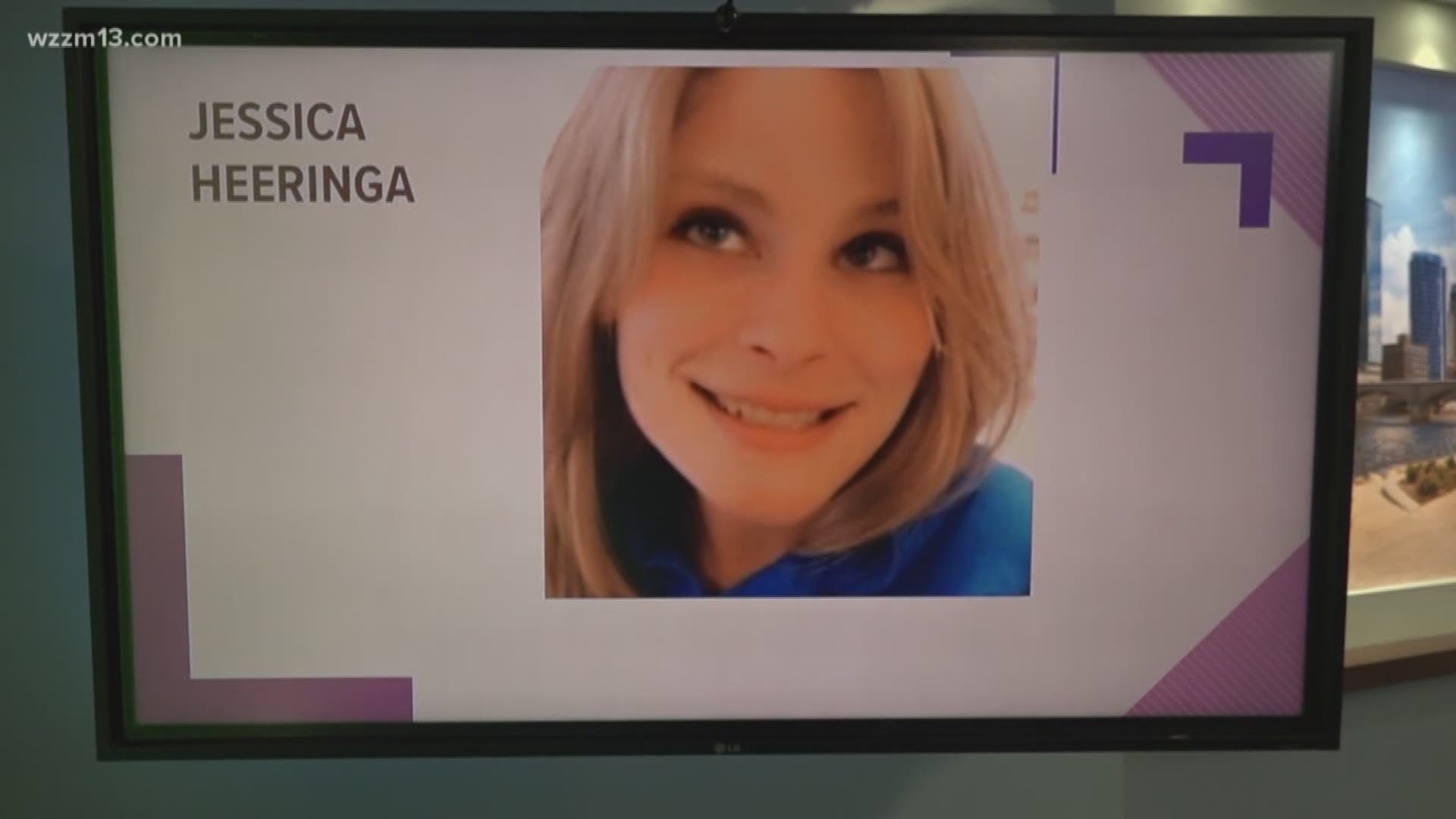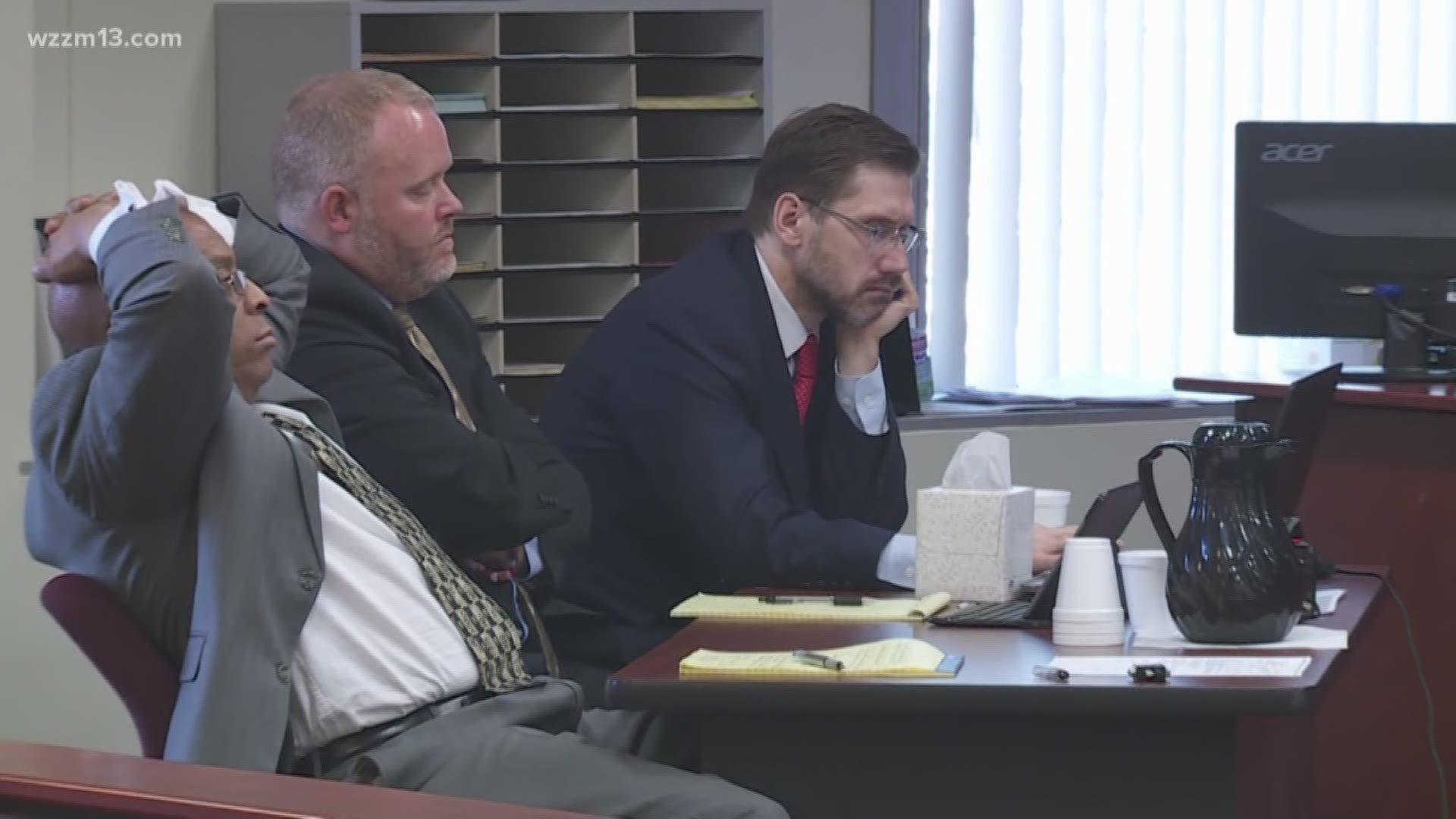MUSKEGON, Mich. - The trial of Jeffrey Willis for the murder of Jessica Heeringa continues with witness testimony Wednesday, May 9, 2018.
Opening statements were heard and the first witnesses testified on Tuesday.
Family and friends had been waiting for this trial for more than five years. Heeringa went missing on April 26, 2013, from her job at a gas station in Norton Shores. The 25-year-old mother was never seen again and is presumed dead though her body has never been found.
Willis, 48, is charged with open murder and kidnapping in the case.
Muskegon County Prosecutor D.J. Hilson is expected to call more than 30 witnesses in total. He was able to get through eight of them on Tuesday and five before lunch on Wednesday.
Honorable William C. Marietti has made the decision to allow cameras in the court room. Once he is seated, a live feed will be provided in the video above. Court is expected to resume around 9:30 a.m.
BLOG
4:45 p.m.
Court goes into recess for the evening. Will resume Thursday morning at 9:30 a.m.
4:44 p.m.
Defense attorney Johnson asks Barber why he and his wife went for a motorcycle ride. Barber says it was a nice night. They stopped for a cigarette in a Wendy's parking lot, no where else.
Barber says the Exxon station just happened to be on their route, it wasn't a planned visit.
Barber says, once they were parked, there was no illuminated light at the back of the store. The only light he could see was from the hatch of the van.
Barber says he and his wife did not get the license plate number of the van. Neither of them called the store to see if everything was OK.
4:31 p.m.
Eric Barber called to the stand. Hilson asks Barber if he recalls the night of April 26, 2013, around 11 p.m. He says yes.
Hilson establishes Barber was married to Susan Follett at the time. Follett worked at the ExxonMobil station. That night, the two of them decided to take their motorcycles for a ride.

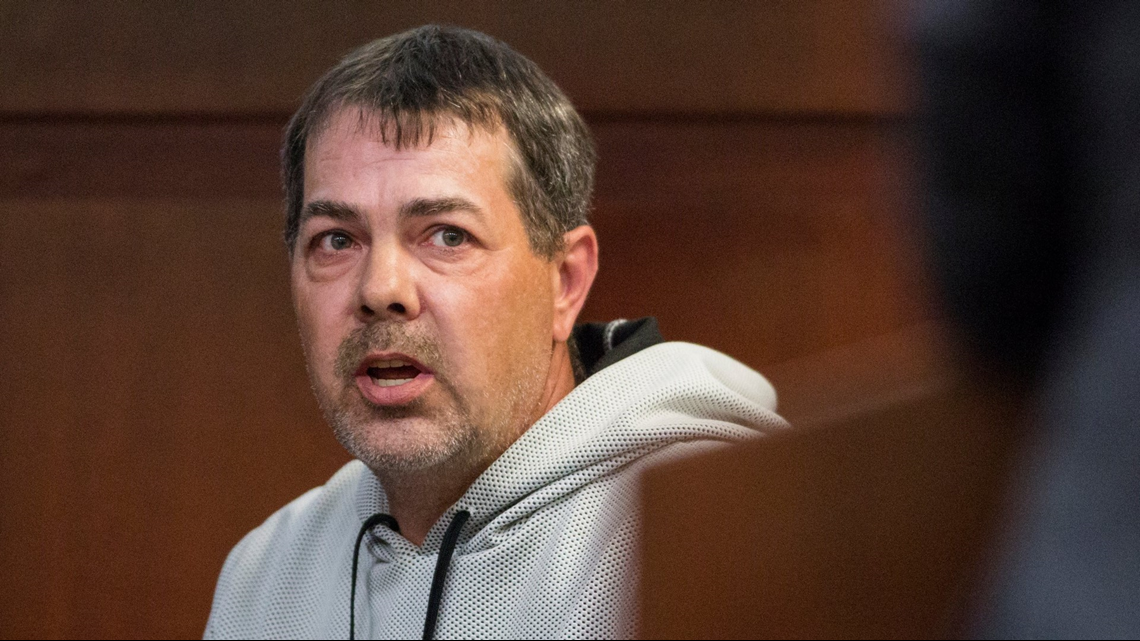
Just before 11 p.m., they rode past the gas station. Barber says he noticed a silver minivan driving by the gas station, in the parking lot -- says he saw it drive toward the back of the building and shut its lights off. It continued moving after shutting the lights off.
Once he and his wife got to Harvey Street, his wife said something didn't look right and suggested they go back. They went back and pulled by the gas station and then parked in the lot at the strip mall.
Barber says a van is parked behind the Exxon station. Says from his vantage point, he saw a light go off and on. The light appeared to be from the back hatch of the van and was lit when the door was lifted.
When the van left, it drove toward where Barber and his wife were parked, so they followed it out of the lot, down the service drive. The van went north on Old Grand Haven Road and he and his wife went south.
Barber says he never got a look at the driver. Could not tell whether it was a man or woman.
As soon as they got home, they got a phone call from Follett's boss. Barber said it was about a 15 minute ride home.
Barber and his wife went back to the gas station and talked to police officers.
4:29 p.m.
Johnson asks how Wauer knew Willis' vehicle was there. He said he had seen it before and recognized it in the lot that night.
4:18 p.m.
Carl Wauer Jr. takes the stand. Hilson asks if he knows Willis, he says yes and identifies him in the courtroom. The two of them used to play a "magic" card game together on Friday nights at a location in The Pointes Shopping Center near the Exxon station. They played on and off for about a decade, according to Wauer.

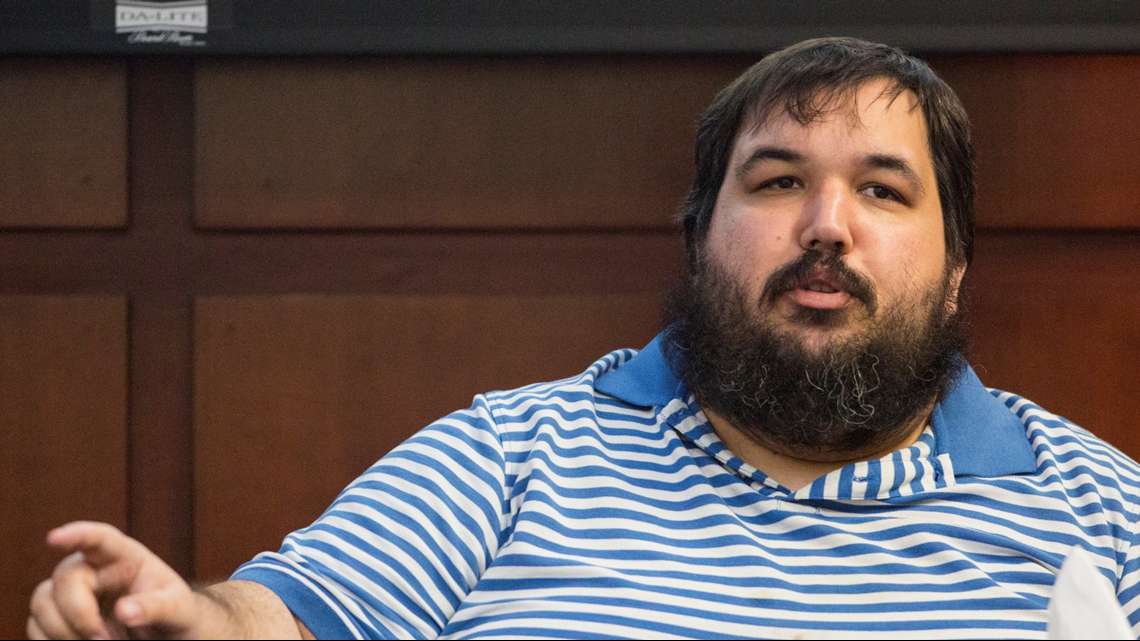
On April 26, 2013, Wauer was at "The Big Game Room" playing poker in the same shopping center. At one point, he walked down to the building to where Willis was participating in Magic: The Gathering Tournament.
Wauer says tournaments were usually over between 10 and 11 p.m. He says he left "The Big Game Room" hours later, after 1 a.m. He remembers seeing a lot of cops at the gas station.
Says he last saw Willis between 9:30 and 9:50 p.m. at the tournament. Will was still playing at the time.
Wauer recalls Willis had recently bought a new vehicle. Says it was some sort of van and he was driving it that night.
4:13 p.m.
Johnson asks Harpster about the lighting in the parking lot of the Exxon. Harpster says it was lit with florescent lights and he could see the other vehicles clearly. Says there was enough light to see people entering and leaving the lot.
Harpster guesses he looked around the store for 3 to 4 minutes before deciding to call the police.
4:03 p.m.
Craig Harpster called to the stand next. Harpster says the Exxon station Heeringa worked at was a frequent stop, but not a regular one -- explaining he only went when he needed something. He worked nearby. On the night of April 26, 2013, he punched out of work at 11 p.m. exactly.

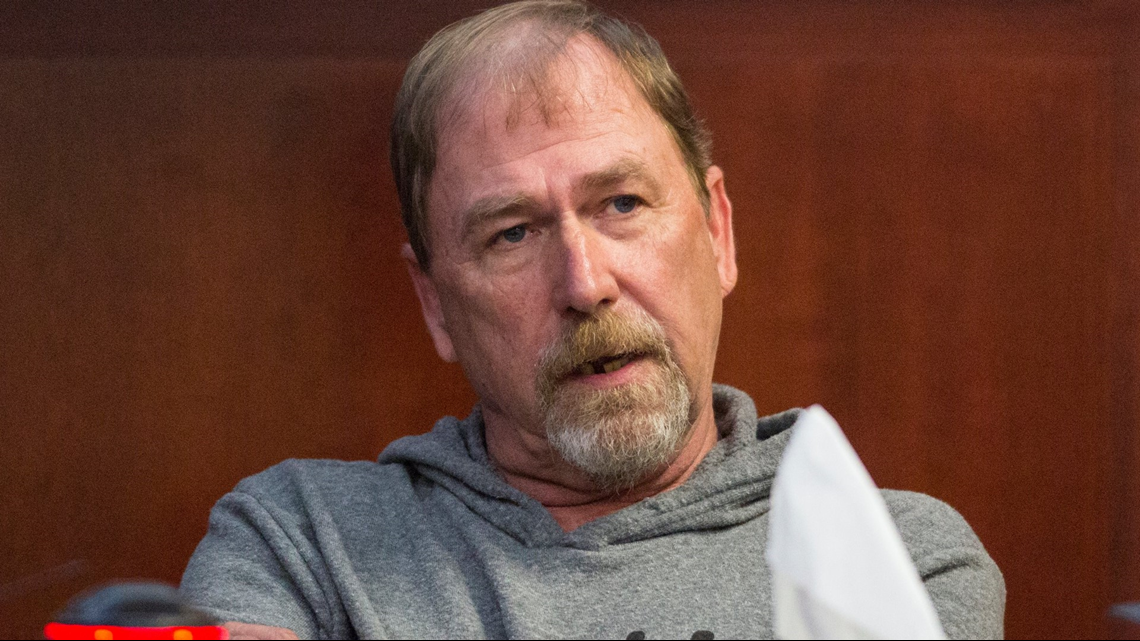
Says it takes about four minutes to get to his car and another four to get to the gas station. That night, he needed fuel. When he got there, he went to pump his gas. He wanted to pay cash and says the pump wouldn't activate. That's when he went inside to see what the problem was.
"There was nobody there," he says of what he found when he entered the store. "The store was definitely open."
Harpster says there were two cars out front of the store when he got there. Claims one of the vehicles was Heeringa's.
Says he walked around the store, check the restroom and checked the cooler, "Seen nobody." The office door was open, there was no one inside. Did not appear there was a struggle anywhere.
"What'd you do after that," Hilson asked.
"Felt like leavin', but my gut said call 911, so that's what I did," he said.
Hilson plays 911 call for the court.
"It's very suspicious that there's nobody here," he said, in part.
Harpster stayed on scene until officers arrived.
3:51 p.m.
Prosecution calls Susan Elliot Mosley to the stand. She was a regular customer of the Exxon station where Heeringa worked. Mosley worked nearby.

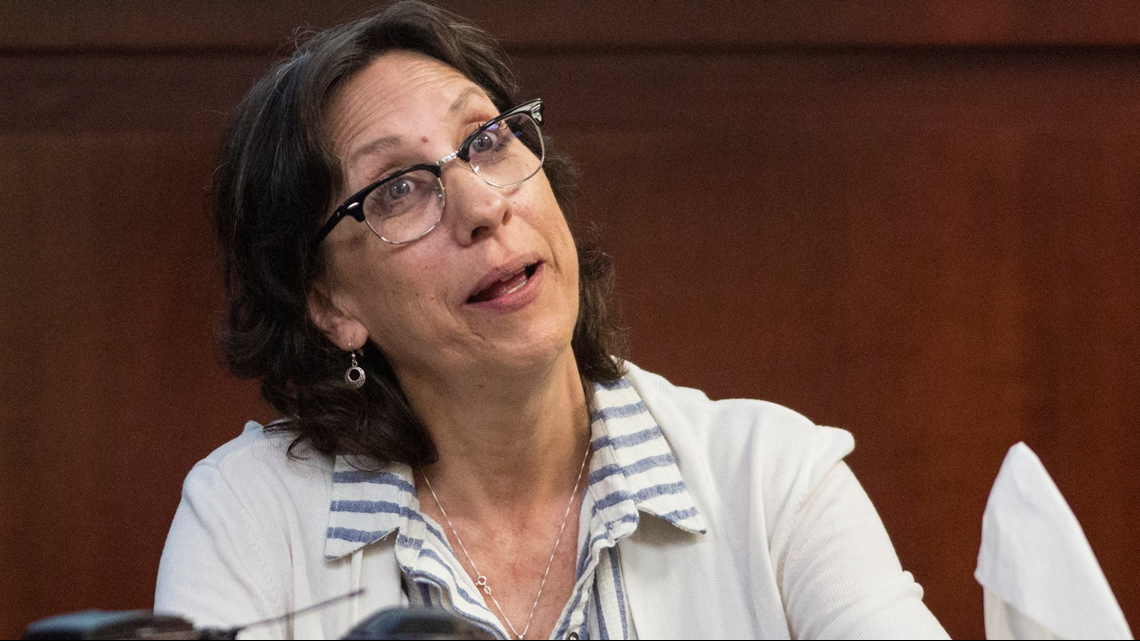
She stopped by the Exxon on April 26, 2018, and says Heeringa was in a great mood, a better one than she was in herself. She was there, according to her receipt, at 10:52 p.m. Mosley says she wasn't there longer than five minutes.
Johnson approaches, asks Mosley if she remembers seeing Heeringa's car the night she was there. She says she cannot remember.
Mosley says shes contacted the police the next day, telling them she thought she was the one who bought a lighter.
Johnson references Mosley's testimony from the preliminary hearing. In her statement, she talked about a man who frequented the store that, "really gave me a bad vibe." Mosley stands by that statement and elaborates. "He just was a creepy, creepy dude," she said.
When asked if Heeringa seemed to have a problem with the man, Mosley said she didn't seem to. She said after asking Heeringa about the man, she said he was fine, and then said to him, "You need to behave or you won't be able to come and visit with me in the evening."
Johnson asks Mosley if that man was the defendant. She says no.
3:45 p.m.
Dyer says Heeringa kept a journal. He says he always knew about it but never looked in it until after she disappeared. He says he turned it over to police. He eventually got it back and isn't sure where it is now.
When asking about the $400 in Heeringa's purse, Dyer says she had just cashed her check and that was rent money.
Dyer says he did not know Heeringa had a second cell phone until the preliminary hearing. He claims Heeringa told her she was skimming money from the store for extra cash.
3:40 p.m.
Dyer says he never met Heeringa's heroin dealer, but he did speak to him over the phone once for about 40 seconds. Says he knew he was her dealer because of text messages he had read.
Dyer says the couple talked about stopping drug use all together. Sometimes they fought about the chores Dyer didn't do around the house and the amount of time, or lack thereof, he spent with his son.
Once they moved in together, they stayed together longer. Dyer says there was no out, so they stayed together -- instead of breaking up.
Dyer tells Johnson that one time a fight became physical.
Talking about the aforementioned jealousy issues, Dyer says they both accused each other of infidelity. He believes Heeringa was talking to other people, but was never in a relationship with anyone else while they were together.
3:32 p.m.
Johnson begins questioning Dyer about his other child. Dyer says he has a daughter who is older than his son. He was never married to his daughter's mother. Johnson asks Dryer if he ever asked Heeringa to marry him. He says yes, multiple times.
"I wouldn't say it was a problem, but money was tight," Dyer says of the couple's financial situation.
Dyer agrees with Johnson that drugs caused more problems in the relationship.
Johnson asks about Heeringa's relationship with her mother, grandmother. Dyer says she had a good relationship with both, but saw her mother more often.
As far as Dyer knows, Heeringa was happy at her job.
3:28 p.m.
Hilson moves questioning to Heeringa's relationship with their son. Dyer says she had a great relationship with him and never wished she didn't have a child. Says he never felt like she didn't want to be a mom anymore.
Dyer says she would never leave her son behind. She's also not the type of person to just get up and leave. If anyone, Dyer believes she would have told her sister she was leaving.
HIlson's final question, "Did you have anything to do with her disappearance?"
"No I did not," he said.
3:15 p.m.
Dakotah Quail-Dyer called to the stand by Hilson. He was Heeringa's boyfriend and the father of her son. Dyer says he recalls Heeringa mostly working the night shift -- the gas station closed around 11 p.m. Says at the time of Heeringa's disappearance, they had been living together for a few years.

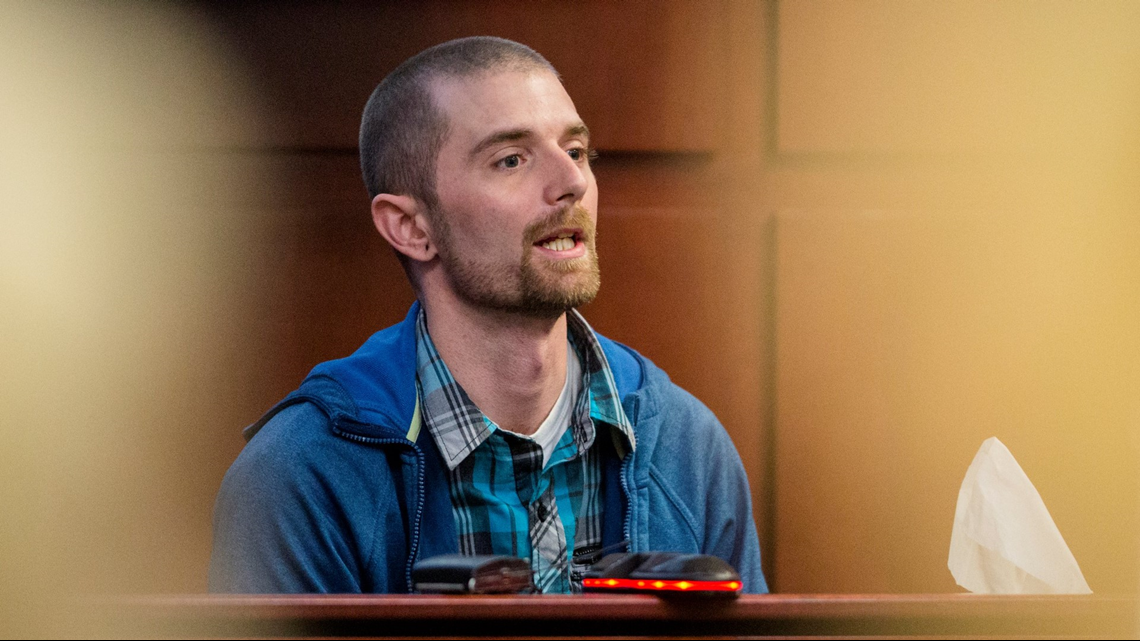
Hilson asks Dyer about employment. He says he was unemployed for about six months and was receiving benefits.
"Rocky and on and off," is how Dyer described his relationship with Heeringa. He says there were some jealousy issues. It wasn't uncommon to break up and get back together.
"We both had drug problems," Dyer says. He also says he did not like it when she used heroin, says they fought about it a lot. Dyer says he even threatened the person she was getting the drugs from.
Saturday, April 26, 2013, Dyer recalls Heeringa going to work around 3 p.m. Before that, the couple went shopping with their son. After shopping, she dropped the two off at his parents house around 2:30 p.m.
Dyer tells Hilson he and Heeringa shared a car and a cell phone. On the date in question, Heeringa kept the car to go to work and Dyer kept the cell phone.
Dyer says he called Heeringa around 8 p.m. and 10 p.m. He called around 8 p.m. to let her know he and their son were home, again later to ask her to bring home groceries. He says in both conversations Jessica sounded like her "normal sunny disposition."
3 p.m.
Ten minute break.
2:43 p.m.
Johnson hands Lt. Crump and image of the items he's been talking about, specifically the two small fragments. One fragment appears to be lead, the other a stone or small piece of the roadway.
2:30 p.m.
Johnson questions Lt. Crump about the highlighter on the documents and the condition of the cartridge found at MJN scene.
Johnson asks, of all the reports in front of him, are any of the victims labeled "Jessica Heeringa." Lt. Crump says no.
2:19 p.m.
After running tests, Lt. Crump says he was able to determine the cartridges were all fired from the same weapon -- the Walther P .22 caliber firearm in evidence.
Hilson presents Lt. Crump with the cartridges from MJN's case. Lt. Crump says there were not enough marks on them to come to a conclusion. Lt. Crump says in his notes, he wrote the cartridges were dented and deformed -- possibly run over, but not corroded.

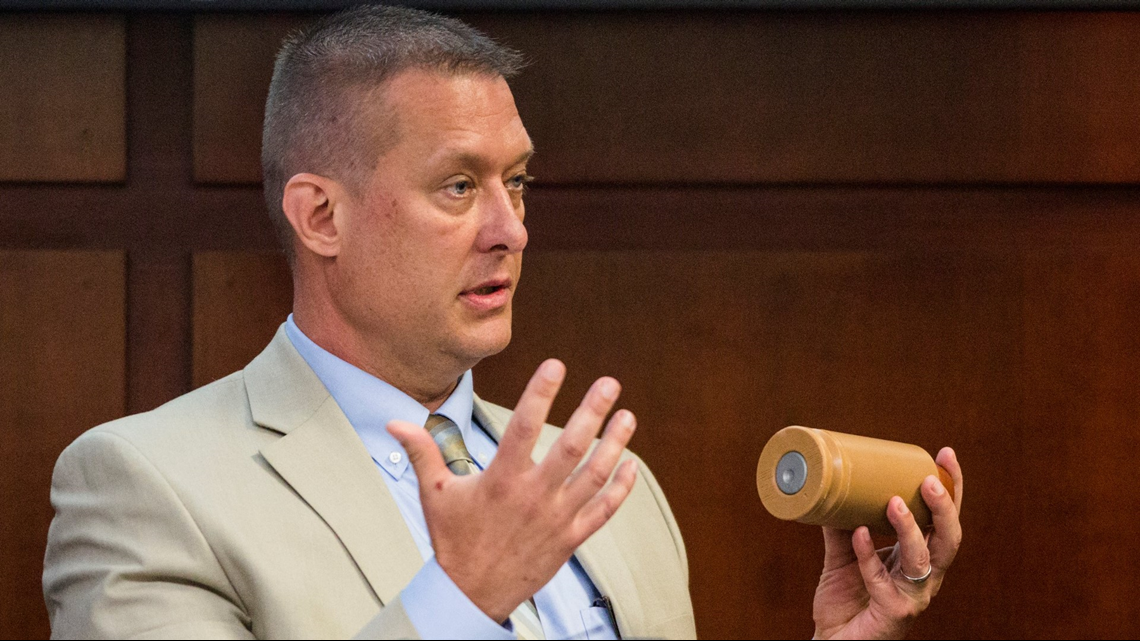
2:09 p.m.
Hilson hands Lt. Crump the firearm from evidence. He says when he got the weapon in the lab, he went through the same process he explained earlier, about test shots, to compare the cartridges and bullets.
The serial number was defaced on the firearm, it wasn't readable, according to Lt. Crump. Says he was able to restore the serial number in the lab. The number restored matched the serial number located on a different part of the weapon.
1:56p.m.
Hilson begins questioning Lt. Crump about the cartridges found at the Bletsch murder scene. Crump confirms all three casings belonged to a .22 caliber firearm.
First step was to determine if they were all fired from the same weapon. All had matching chamber marks, according to Lt. Crump -- meaning they were loaded into the same chamber.
Next, Lt. Crump was given bullet fragments to look at. Says he didn't have enough to conclude all were fired from the same firearm without the firearm in question. If he had the weapon, he says he would likely be able to draw that conclusion.
1:33 p.m.
Judge Marietti and the jury return from lunch, court resumes.
Prosecutor Hilson calls Lieutenant Jeff Crump to the stand. Lt. Crump works for Michigan State Police as a firearms examiner.
Lt. Crump explains through the science of examining certain evidence, he can determine what weapon a bullet and/or cartridge was fired from. Additionally, sometimes results are inconclusive.
1:30 p.m.
Court expected to resume after lunch break at 1:30 p.m.
11:55 a.m.
Lunch break. Court to resume at 1:30 p.m.
11:45 a.m.
Gwen Moeggenborg called to the stand next. She works for Herman Miller in the human resources department. She is also involved in payroll and timecards. She starts by explaining the hours of third shift at Herman Miller. Employees work 9:45 p.m. to 5:45 a.m., beginning Sunday evening and ending Friday morning for the week.

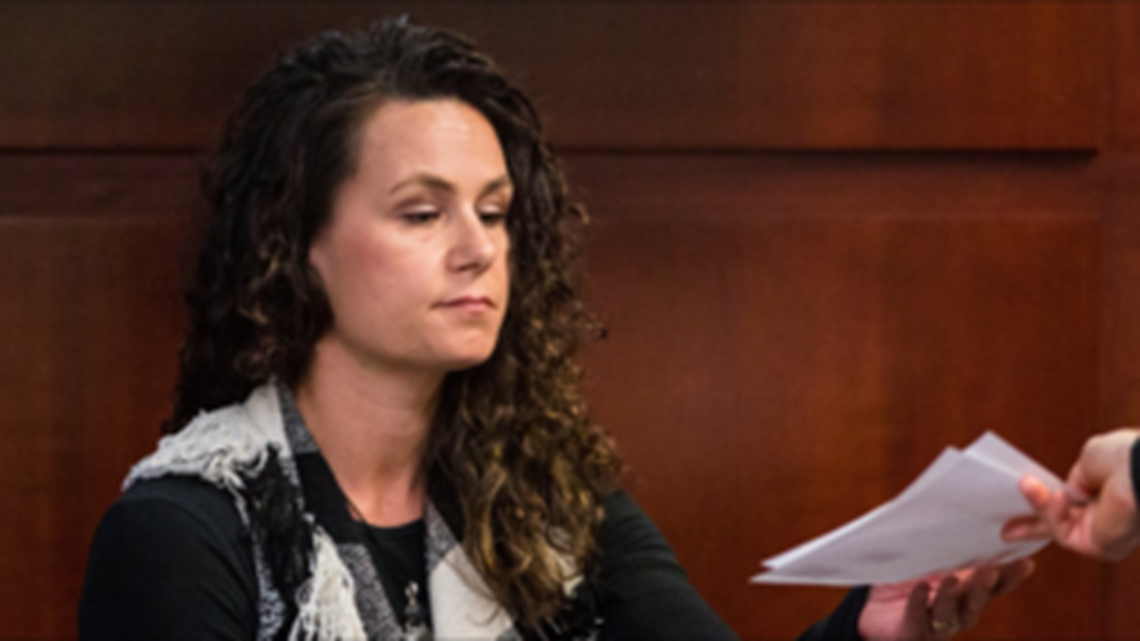
Based on records, Willis missed work Monday through Wednesday, March 4 through 6 in 2013.
Hilson now asks Moeggenborg if Willis worked a regular week the week Heeringa went missing. Moeggenborg says he worked Sunday through Thursday of that week and had Friday, April 26 off.
11:36 a.m.
Johnson asks Schnotala about the last time she remembers seeing the gun. She says the weekend of Feb. 22, 23. Nothing further.
Hilson asks Schnotala if there were ever times during an average week where neither her nor her husband were at home? She replies yes.
11:27 a.m.
Johnson asks Schnotala about Willis' appearance. She says she has only seen him clean shaven, "maybe once," but she doesn't know when that was.
"Friendly, friendly co-worker, everyday conversation," Schnotala says of her relationship with Willis.
Schnotala indicates she was still married when Willis rode the snowmobile by. Says Willis knew her husband's schedule.
Johnson asks if Schnotala remembers seeing any footprints in the snow by the snowmobile tracks. She says no.
"Is it true that the scratches that you noticed -- how sure are you of the date you noticed those scratches?" Johnson asked. The drawing she made of them was 3.5 years after the date in question.
"I don't," she responded.
Asking now about the panties, "Is there something about those panties, a modification, that makes you certain they are yours?" Johnson asked.
"No," Schnotala responded.
11:18 a.m.
Hilson jumps to the Sunday after Heeringa went missing. Both Schnotala and Willis were working that evening. She recalls him having scratch marks on his arms. She says she asked him about them and he told her he had a new, playful puppy that caused the marks.
Hilson moves on to the underwear that was found in the shed on Willis' property. He takes them out of the evidence bag and asks Schnotala if they look familiar to her. She says, "Yes, they are mine." She says they would have been in the same bedroom her gun was in.
"There should be no reason," Schnotala says after Hilson asks if there is any reason her underwear would be in Willis' possession. She says despite Willis asking her for her underwear in the past, she never gave him any.
Schnotala says she never thought her gun was stolen. She thought maybe she misplaced it. She says when she left town and locked her doors, she would remove it from her bedroom and hide it in her attic -- never in the same spot. Says she was never too worried about it because she didn't use it and just figured it was in her attic somewhere.
11:15 a.m.
Hilson presents map of where Schnotala lives. She points out a snowmobile trail that is pretty close to her home. Says there is only one way in and out to her home, long driveway.
"Is there any reason the defendant should ever have your gun in his possession?" Hilson asked. "No," Schnotala responded. "He was a coworker, and that's it?" Hilson asked. "Yes," she responded.
11 a.m.
Michelle Schnotala called to the stand. She works for Herman Miller, she has been there 23 years. She works third shift with about eight other people in her area. She worked with Willis beginning in 2010, she thinks. They worked in the same area on the same shift. They worked together in April 2013. Schnotala says Willis was her material handler. She was a machine operator.

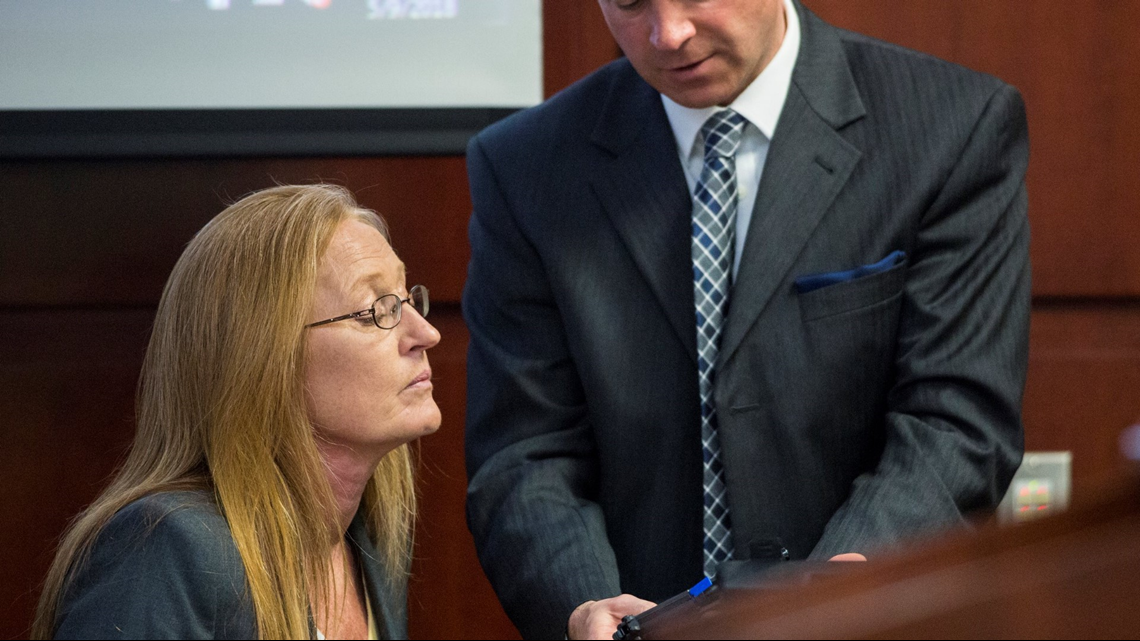
Schnotala says at one time she was a gun owner. She used to own at .22 Walther. She doesn't remember exactly when she bought it, says all the paperwork was missing. Hilson hands her document, says it is the purchase permit from Gary's Guns. The document says she bought the gun on May 1, 2012.
Says it is the same gun in the evidence box Hilson handed her, just missing the laser sight that she bought it with. Hilson presents another weapon, this one has a laser sight, Schnotala says that is exactly what her gun looked like when she bought it.
Schnotala doesn't consider herself a gun person. Says she only shot it a couple times, maybe three, after she bought it. All three of those times, it had the laser sight. She says she never removed it.
She says she talked about the gun at work, with coworkers, including Willis.
Schnotala says she stored it in her bedroom closet, in a case on top of a shelf. Says it was visible to anyone standing in the bedroom.
When asked, Schnotala said she rarely locked her house doors. She only locked them when she knew she was going to be gone for multiple days at a time. She never locked the doors when she went to work and says she never had an issue with that.
The last time she says she saw her gun was the weekend of Feb. 13, 2013.
In March, she saw "unusual" snowmobile tracks in her yard in March. She says she was working that week. She saw the tracks in the morning, around 6 a.m. when she got home from work. Says they were all around her home and driveway. Says she suspected it was Willis because he had ridden around her house before, had admitted to it.


10:45 a.m.
Ten minute break.
10:35 a.m.
Defense attorney Johnson asks Harris about the number of bullet fragments. They add them up together from the report, totaling six. Then they add them in the photo evidence, and the total is seven. Hilson objects, saying the doctor never totaled them, just referred to them as "fragments." Johnson says by counting the number in the report, there are only six.
Johnson moves on to image of shell casing from MJN's kidnapping attempt, asks Harris what he sees. Harris says it looks like a .22 caliber bullet and that based on the photo, it does not appear to be in "pristine" condition.
10:23 a.m.
Hilson asks Harris about Bletsch's autopsy report. Harris says there was evidence that was seized from the autopsy. That evidence was multiple bullet fragments from Bletsch's hair, skull and brain. In total, the doctor identified four different wounds on her head.
10:15 a.m.
Brian Harris called to the stand next. Harris has been in law enforcement for 30 years. He was with the Muskegon County Sheriff's Department for 28 of those years, with 7-8 years in the detective bureau. He retired two years ago from the MCSD and now works for the Norton Shores Police Department.

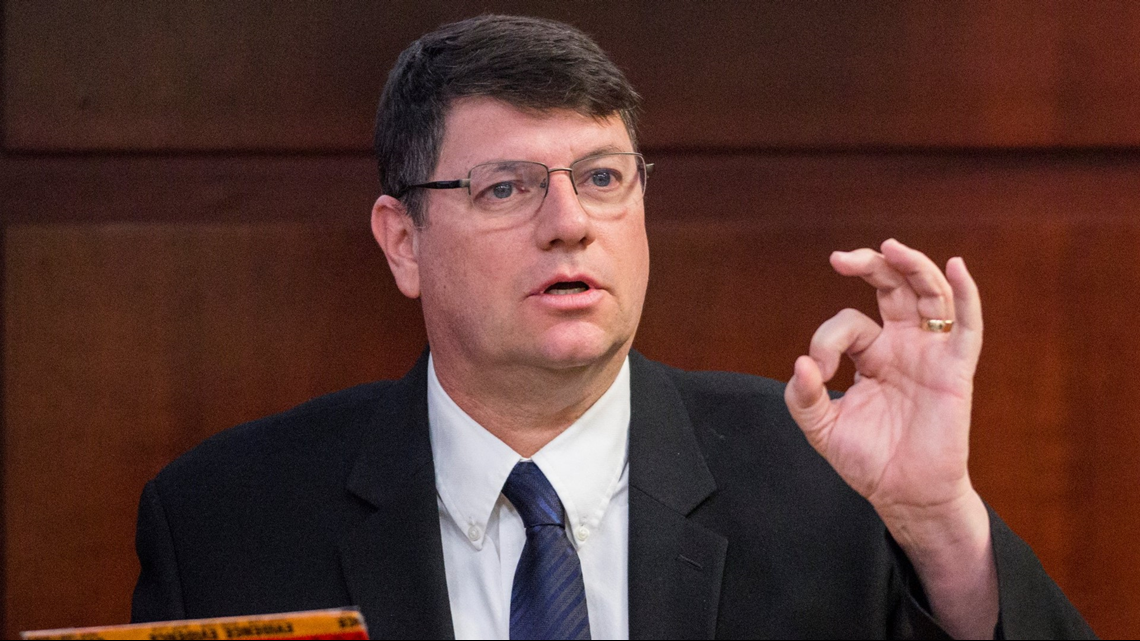
Harris was dispatched to Bletsch's crime scene. He took photos and collected evidence -- including her belongings and the shell casing.
Harris talks about second shell casing he found at the scene. It was in the tall grass near the blood spots, approximately 2.5 feet away. Hilson points out this shell casing is much closer to where Bletsch was than the one found in the middle of the road.
After returning to the scene at a later date, another shell casing was found. This one was near the second one, still close to the blood spots.
Hilson recaps, in total, three shell casings were found at the scene -- all .22 caliber, CCI manufacturer.
10:06 a.m.
Johnson begins questioning Dr. Rood by asking about delivering insulin into the body, specifically using the pump method. Rood explains that process, agrees with Johnson that the pump isn't always 100 percent accurate or fool proof through human error. Johnson asks if someone with a pump could still need a syringe injection in an emergency. Rood says yes.
Johnson asks if someone without diabetes goes into a coma or is incapacitated by insulin, should they go the hospital or if they can come out of it on their own. Dr. Rood says there could be brain damage and should seek medical attention, but it's not impossible for them to come out of it on their own.
Dr. Rood agrees that even when absorbed quickly, the impact is not like in spy movies, "where the guy gets stabbed in the neck and falls down."
10 a.m.
Hilson shows evidence image of vial, syringes and weapon. Dr. Rood says the vial is fast acting insulin, syringes are capable of holding 50 units. Says giving someone 50 units and not feeding them could cause them to have a glycemic reaction.
Hilson shows image of injection site diagram. Dr. Rood says training is given to those who have diabetes about injection sites. That training is also encouraged for significant others of those being treated.
9:46 a.m.
Dr. Robert Rood called to the stand next. He specializes in diabetology, the diagnosis and treatment of diabetes. Hilson asks him to explain what happens when your blood sugar is too high or too low and the use of insulin.


Dr. Rood explains the different methods insulin can be administered into the body and the proper way to store it -- refrigeration preferred, room temperature is OK. Rood says storing in a car will render the insulin ineffective if the temperature is above 85 degrees.
Hilson moves questioning to administering insulin to someone without diabetes. Dr. Rood says the impact depends on the amount given. Giving someone 5 units or less won't have much affect., more than that could incapacitate someone, or even put them in a coma -- depending on the type of insulin and how much. The duration of the impact also varies depending on the type of insulin. Weight of a person is also a factor on how impacted a person is. An obese person with diabetes could take as much as 150 to 200 units of insulin a day, Rood explains.
9:45 a.m.
Defense attorney Fred Johnson cross examines Deputy Foster. Foster says Willis' vehicle was seized at the time of the traffic stop. Says the car was towed away, not driven.
9:35 a.m.
Jeffrey Willis enters the courtroom. Jury enters shortly after. The second day of witness testimony begins with Prosecutor Hilson calling Deputy Scott Foster to the stand.
Deputy Foster is in the road patrol division for the Muskegon County Sheriff's Department. He was on duty the evening Rebekah Bletsch was killed. He was called to the scene on Automobile Road on June 29, 2014.

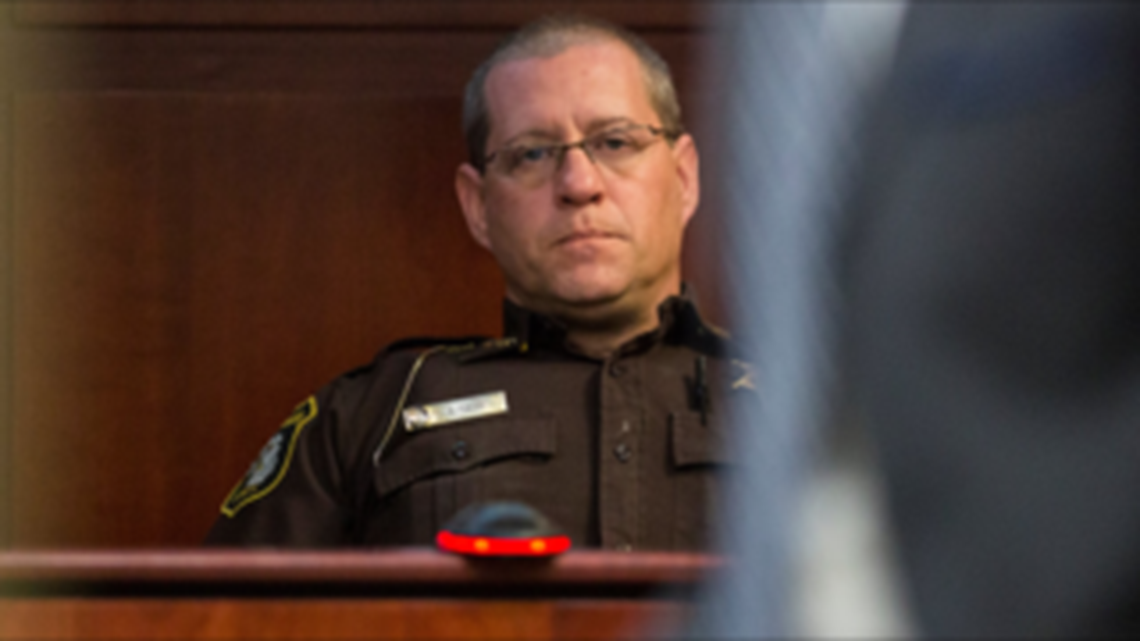
Deputy Foster describes the scene and talks about Bletsch's injuries. Hilson shows graphic photos of Bletsch's bullet wounds. Foster confirms after they found the two wounds, the investigation changed from a hit and run to a homicide.
Foster also talks about the .22 caliber shell casing found at the scene. This was talked about at length yesterday. Click here to read more.
Prosecutor Hilson fasts forwards to 2016 when Deputy Foster conducted the traffic stop on Jeffrey Willis. Foster identifies Willis as the driver, in the court room today.
►Make it easy to keep up to date with more stories like this. Download the 13 ON YOUR SIDE app now. Kayla Fortney is the senior multi-platform producer at 13 ON YOUR SIDE. Have a news tip? Email news@wzzm13.com, visit our Facebook page or Twitter.

